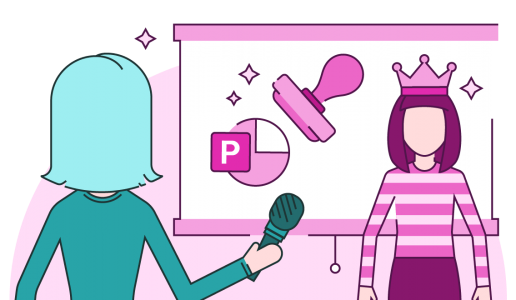Designing presentations for cognitive disabilities
Find out how you can make more accessible and inclusive presentations by thinking carefully about fonts, layouts, colours and structure.

At BrightCarbon we know that a well-constructed presentation template is the foundation on which polished and professional presentations are built. Today I have the pleasure of interviewing BrightCarbon’s new Templates Lead, Gemma Leamy, and picking her brains on the ideal process for creating robust PowerPoint templates.
Before joining BrightCarbon I worked as a Glass Designer, which involved developing homeware and tableware designs in-house as well as for external clients such as large department stores. I loved gathering inspiration for the NPD (New Product Development) process by doing trend research and visiting trade shows. This would then be developed into mood boards and the story of a new design would be presented to our team. Once a product got the go-ahead then it was important to develop a detailed technical drawing and communicate expectations and feedback clearly with the production workers in the factory, who could be in-house or halfway across the world! Moving into the presentation world seems like a big departure, but I’ve found there has been so many transferable skills and business knowledge which gives me a great insight and understanding of our clients’ industries.
My aim as Templates Lead is to develop our template and toolkit service further and ensure we are creating the very best product possible for our clients. During my time at BrightCarbon I’ve worked on many PowerPoint templates for both small and large enterprises, and love how a well-made template can make life easy for their users who are creating presentations daily. I’ll be researching what is currently working well and where we might be able to improve our offering so that the end product adds real value for our clients. Our team has so much technical and design expertise, so I’d love to develop our training and resources to share our knowledge around PowerPoint templates and help people make brilliant on-brand presentations easily.
Yes, creating templates is a surprisingly difficult balancing act of technical knowledge, project management, and design expertise! One of the biggest challenges is that we naturally want to create a template that will fix everything and magically create perfect slides for us, while there will always be an element of manual user input needed. We often find that even the smallest amend has a knock-on effect across the rest of the template, and knowing the impact of these small changes only comes with experience. PowerPoint will always have its limitations, but I’m constantly amazed to see the brilliant macros and add-ins our wonderful team of developers can produce.
A few of these add-ins are available publicly – check out our Products page!
We often work with large organisations who are in the process of rebranding. Often, a design agency will create a gorgeous new design, but they may lack the technical expertise you need to create a functional template and the file simply doesn’t work for everyday users. This is where our expertise can help. We can create a template which is both beautiful and functions brilliantly for every user in the organisation.
Our process can look different for each template project, it’s very much dependent on the needs and size of the organisation. We like to be flexible and ensure that what we are creating fits any business needs so there are a few options we can choose to put into place.
Often, we’ll start by conducting an audit of current materials as this gives us a great insight into the types of layouts that might be useful for users. We might also conduct user interviews to understand how everyday users are creating slides, and what issues they are facing. When it comes to building the template, we’ll create a design sample to ensure the layouts are on-brand, then we’ll jump into a full build where we concentrate on functionality alongside design.
User testing can be a useful tool to ensure the template is working well for everyone and can take various forms depending on the size of the organisation. There are usually multiple ways to approach any issues that arise so this is where we can adapt our technical solutions to suit users. Once the template is complete and deployed throughout the organisation, we often follow up with training sessions tailored to the organisation so that users can make the most out of their new PowerPoint toolkit and learn some new skills while they’re at it.
There are so many benefits to a professionally made PowerPoint template! Firstly, it ensures the template is fully functional from the outset, in a business sense this saves lots of time and money fixing problems down the line. There’s lots of technical processes involved behind the scenes and at BrightCarbon we aren’t just experts in the technicalities, but also in combining that with beautiful design keeping your users in mind.
For the everyday user, a custom-made template and toolkit creates a single place where they can access brand assets formatted specifically with presentation creation in mind. This makes it super easy to create consistently branded decks, saving users time and allowing them to concentrate on content creation without worrying about design. And of course, when your presentations look professional and well-designed, you’re much more likely to have a positive outcome and keep your viewers engaged.
A valuable aspect of working with an agency like BrightCarbon to create your template is that we are able to see things from an outsider’s perspective and collaborate with you on a solution which suits your organisation. We can look at your existing content and create customizable toolkit layouts which are really easy to use and look great. Since we’re looking at the full picture, we can make suggestions on maximising the use of your template. This might include advice on presentation messaging and structure, or specific training which might be helpful for your team. To put it simply, a professionally made PowerPoint template makes life much easier, and saves time and money!
My colleague Lucy recommends always setting grids and guides in your template. This way, all users can create strong layouts which are consistent and flow smoothly throughout presentations. By using the Slide Master in PowerPoint, you can easily amend the gridlines to work for specific layouts to help guide users in where to place content, although we’d always recommend keeping the overall slide margins in a consistent position. This will keep any presentations made using your new template looking polished and professional.
A useful starting point: Advanced PowerPoint grids and guides
My top tip would be to think about your colour palette in advance. When adding your brand palette to a PowerPoint template, knowing how theme colours populate your presentation will save you a headache down the line and improve overall usability. The order you input the colours is important. The first four colours affect Background Styles, giving you the ability to create light and dark variations of your template, and they also pull through to aspects of tables and graphs. The six accent colours pull through to charts, tables, and SmartArt in the order they are inputted. It’s really important to think about accessibility at this stage by ensuring that when colours are next to each other there is enough contrast for content to be legible, whether it be printed for readers or shown on a large conference screen.
A useful starting point: How to change theme colors in PowerPoint
Thanks Gemma! It’s clear that there’s a lot of work that goes into successful presentation templates especially for large organizations. But if our readers are brave enough to give it a go, we’ve got the perfect guide right here: How to create PowerPoint templates that work
Leave a comment
Find out how you can make more accessible and inclusive presentations by thinking carefully about fonts, layouts, colours and structure.
We’re calling out one of the major injustices of corporate rebrands across the globe – PowerPoint falling to the bottom of the rebranding checklist. We discuss why it's a problem and how to fix it!
How can you quickly create on-brand, polished materials for your next event? Here are 3 trade show booth ideas you can make in PowerPoint.
Join the BrightCarbon mailing list for monthly invites and resources
Tell me more!No one was looking at their electronics; all eyes were on the podium. We raised the bar on what a great presentation is supposed to look like.
Curtis Waycaster Smith & Nephew
